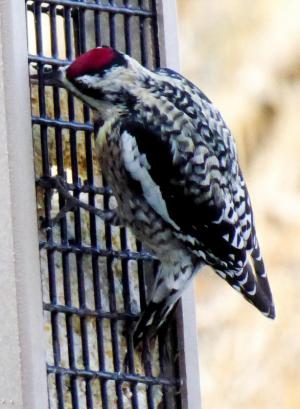Mill Pond Garden shares tips for winterizing
As Mill Pond Garden prepares for winter, its team encourages all gardeners to consider what to do and how to do it in preparation for the coming cold season.
These tips include a variety of measures to be taken and the reasons for them, covering water systems, outdoor furniture, lawns, beds, leaves, planting, pruning, tools, wildlife, and outdoor art like light displays.
Irrigation systems should be blown out by a professional company to avoid freeze damage. Hoses should be drained and capped, and stored out of the sun. Outdoor faucets should be insulated and capped. Outdoor showers need to have the indoor supply turned off and outdoor shower piping drained by opening all the valves.
Because winter has very dry air that desiccates leaves, keep a bucket near a spigot to water any outdoor potted hardy evergreen or annual ornamental plants that might need it.
Outdoor furniture should be thoroughly cleaned, then covered to keep off dirt and prevent sun damage. Leave the bottom open to maintain air circulation and avoid mold. Black mold makes permanent stains, so if possible, use furniture covers that admit sunlight, which kills mold. There are rolls of clear wrapping available in some box stores that can be used effectively as seen on stored boats.
Before the first hard freezes, gardeners should bring into non-freezing storage any tropical plants that would be killed by cold. A garage often suffices if some house heat is supplied or an oil heater is kept in the garage to keep temperatures about 50 degrees plus.
Lawns should be fertilized with 10-10-10 lightly in the first week or two of December, and left cut high to help keep light away from winter weeds, preventing seed germination.
Recycle-mow fallen leaves a couple times. The fine pieces will soon disappear, feeding the soil and the worms. Earthworms need this food and will keep soil deeply aerated for fertilization of beneficial microbial populations. Leaves are a valuable resource that should not be discarded.
In tree, shrub, and flower beds, rake or blow the excess leaves off, so ground covers are not blocked from light. Blow them onto a lawn or paved surface where the mower can run over them a few times. Then blow the fine particles back into the beds to benefit them. Keep some leaves under shrubs and on vegetable beds to provide the birds hunting areas, food for worms, and protection from erosion caused by hard rains. Some leaf cover also helps the beneficial microbes. Spotless garden beds are not eco-friendly.
Planting of hardy woody or perennial plants can be done right up until the ground freezes. Make sure the plant is located for proper drainage and sun. Add some compost to the hole backfill and use Espoma’s Biotone, which is a dose of beneficial microbes, sprinkled in the planting hole and on top. These microbes will speed up the acclimatization of the plant’s roots and quicken new growth of root hairs. Do not pack down the soil around newly planted plants; instead, water the plant in thoroughly and the soil will settle naturally around voids but leave air pores for the plant to breathe and roots to succeed.
Winter is a good time to prune woody plants when branch structure can be seen to guide cutting. Remove unproductive stems in flowering shrubs, other dead wood and branches that rub against others or go the wrong way, and those that grow in the way of other plants or against the house.
For young trees especially, shaping while young can direct growth, beauty, and structural soundness. Some trees have sharp, crowded-together branch-to-trunk crotches which are inherently weak and likely to break the tree apart when larger. Choose the sturdiest of the two and cut one of them out, not the leader, while still young. The strongest branch-to-trunk connections are sideways, at an angle of 45 to 90 degrees.
For wildlife, especially birds, provide a heated bird bath and daily fresh water. Clean out bird boxes and dust insides with sulfur dust to kill mites. Birds can benefit a lot from feeding a good-quality mix of seeds high in sunflower seed. A suet feeder will not only benefit many birds but attract some of the most picturesque like wrens, woodpeckers and nuthatches. A high pole and a squirrel baffle are necessary. The bird bath is most important of all. Birds perhaps bathe more in winter than in warm weather since they need clean feathers to insulate themselves against the cold. Plant some bushy, large-leaved evergreens to provide birds shelter from winter winds and freezing.
A good-sized rock pile will attract lizards, skinks, salamanders, frogs, bumblebees and garter snakes; all of these are the best pest control all year. Even a very small pond will benefit frogs, and many small wild animals looking for a drink of water.
Clean and oil garden tools. Use up lawnmower gas, as it will become gummy if left all winter and cause problems in spring. Clean up storage areas. Repair fences. Put a snow shovel in the entry hall closet. When it snows enough, clean access to water and feeders. If heavy snow falls, brush off any fragile evergreens that might break under the weight.
Store outdoor lights in sturdy weatherproof poly boxes in a shed.
Mill Pond Garden is a nonprofit, holistic, public botanical garden serving the Cape community year-round at 31401 Melloy Court, Lewes. Tickets for the Garden of Lights show are available for good weather dates Thursday to Saturday, Dec. 17 to 19, on the website where one may also subscribe free at millpondgarden.com.




















































